Schnucks is a supermarket chain. Based in the St. Louis area, the company was founded in 1939 with the opening of a 1,000-square-foot (93 m2) store in north St. Louis and currently operates over 100 stores in four states throughout the Midwest. Schnucks also ran stores under the Logli Supermarkets and Hilander Foods banners. Schnucks is one of the largest privately-held supermarket chains in the United States and dominates the St. Louis metro grocery market.

2000 Pennsylvania Avenue, also known as The Shops at 2000 Penn and Red Lion Row, is a shopping center and eight-story office complex located on Pennsylvania Avenue, NW in Washington, D.C. It forms a busy gateway into the main campus of the George Washington University, which owns the property. As the 2000 Block of Eye Street, NW, the houses were named a DC Landmark and added to the National Register of Historic Places, both in 1977.

The Hackensack Water Company Complex is a set of historic buildings in Weehawken, New Jersey, registered in the U.S. National Register of Historic Places. The Hackensack Water Company, a predecessor of Suez North America, developed water supply and storage in northeastern New Jersey from the 1870s to the 1970s, initially to provide service to the city of Hackensack and the towns of North Hudson. Originally its headquarters and major facilities were located at Hackensack, in Bergen County. Under Robert W. de Forest, who ran the Hackensack Water Company for 46 years beginning in 1881, the company constructed new facilities and moved its headquarters to Weehawken in Hudson County, setting up offices in a brick water tower, part of the present complex.
Winnona Park is a historic area in the southeast corner of the Atlanta, Georgia suburb of Decatur. It is listed as a historic district on the National Register of Historic Places, but it is not one of the City of Decatur's locally designated historic districts.
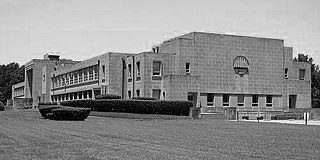
Vollintine Hills Historic District is a historic district located in the Midtown area of Memphis, Tennessee, notable for its cohesive collection of 78 post-World War II Minimal Traditional and ranch-style houses built around a former synagogue. "The neighborhood represents the efforts of members of an Orthodox religious group to accommodate their beliefs by developing a synagogue and housing for the congregation within easy walking distance."

The Broadway Historic District is located along Broadway in Saratoga Springs, New York, United States. It has a twofold character. The southern section is the commercial core of the city, with many of its important public and private buildings, most intact from its peak days as a resort town in that era. North Broadway is a residential neighborhood with many large Victorian houses built by frequent visitors to the town and its spas and racetrack.

There are 75 properties listed on the National Register of Historic Places in Albany, New York, United States. Six are additionally designated as National Historic Landmarks (NHLs), the most of any city in the state after New York City. Another 14 are historic districts, for which 20 of the listings are also contributing properties. Two properties, both buildings, that had been listed in the past but have since been demolished have been delisted; one building that is also no longer extant remains listed.
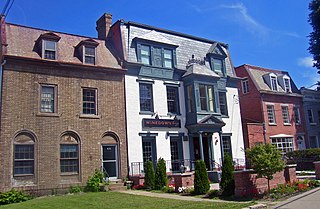
The Union Street Historic District extends along a section of that street in Schenectady, New York, United States. Covering roughly two miles (3.2 km) of both sides of the street, it includes 184 buildings in its 65 acres (26 ha).

The Kingston Stockade District is an eight-block area in the western section of Kingston, New York, United States, commonly referred to as Uptown Kingston. It is the original site of the mid-17th century Dutch settlement of Wiltwyck, which was later renamed Kingston when it passed to English control.
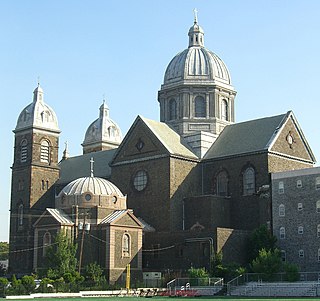
The Monastery and Church of Saint Michael the Archangel, known locally as Saint Michael's Monastery Church, is a state and national historic place in Union City, Hudson County, New Jersey, United States. Formally opened in 1869 and completed in 1875, the grounds of the complex are bounded West Street and Summit Avenue between 18th and 21st Streets. The small street leading to its front entrance from the east is called Monastery Place. At one time the largest Roman Catholic church in Hudson County, it has since become home to a Presbyterian congregation while part of the grounds are used for housing and education. At one time its walls were adorned by artwork by Hildreth Meière, until rain damage prompted their removal from public view.

First United Methodist Church is a historic congregation of the United Methodist Church in downtown London, Ohio, United States. Founded in London's earliest years, the congregation worships in a historic church building that was built in the 1890s.
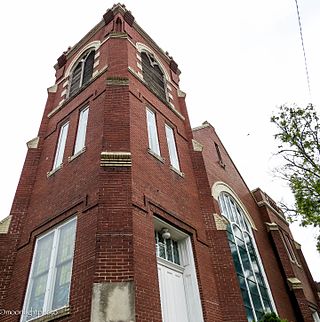
Asbury United Methodist Church, originally Highland Park Methodist Episcopal Church, is a historic church on Bailey Avenue in Chattanooga, Tennessee.
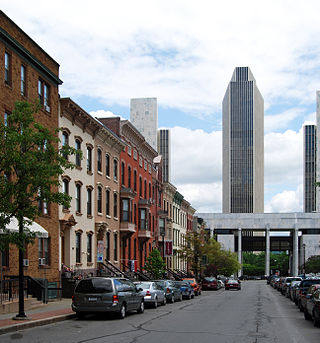
The Center Square/Hudson–Park Historic District is located between Empire State Plaza and Washington Park in Albany, New York, United States. It is a 27-block, 99-acre (40 ha) area taking in both the Center Square and Hudson/Park neighborhoods, and Lark Street on the west. In 1980 it was recognized as a historic district and listed on the National Register of Historic Places.
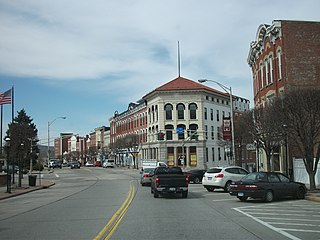
The Downtown Ossining Historic District is located at the central crossroads of Ossining, New York, United States, and the village's traditional business district known as the Crescent. Among its many late 19th- and early 20th-century commercial buildings are many of the village's major landmarks—three bank buildings, four churches, its village hall, former post office and high school. It was recognized as a historic district in 1989 and listed on the National Register of Historic Places, as one of the few downtowns in Westchester County with its social and historical development intact.

The 27th Street Historic District is a historic district in the South Los Angeles area of Los Angeles, California. The district was listed on the National Register of Historic Places in 2009 as part of the multiple property submission for African Americans in Los Angeles.

Camp Curtin Memorial Methodist Episcopal Church, also known as Curtin Heights Church and Camp Curtin Memorial-Mitchell United Methodist Church, is a historic Methodist Episcopal church located in Harrisburg, Dauphin County, Pennsylvania.

The Montrose Historic District is a national historic district located in Montrose, Susquehanna County, Pennsylvania. The district encompasses 386 contributing buildings and two contributing sites in the central business district and surrounding residential areas of Montrose.
The Second and Third Avenue Historic District is located in Cedar Rapids, Iowa, United States. It was listed on the National Register of Historic Places in 2000. At the time of its nomination it consisted of 186 resources, which included 176 contributing buildings, and 10 non-contributing buildings. This area was developed as a streetcar suburb at the turn of the 20th century. It includes single-family dwellings, apartment buildings, and two churches. The upper part of the district is called the Sampson Heights Addition. It was developed by Ellen Bever Blake and realtor/developer Malcolm Bolton. Blake's brothers James and George Bever developed the lower part of the district that they called the Bever Park Addition. The family members were in litigation for four years over the development as the two Bever sisters maintained that the three brothers received a disproportionate share of the property in their father's estate, and that they never paid for their stock in the Bever Land Company. In the end, their father's will was set aside and the five children agreed to divide the estate equally.
















